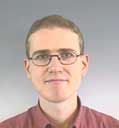Ernest AGUILO
Universitat de Barcelona
aguilo@ecm.ub.es

For my Ph.D. thesis I am working on the preparation ofLHCb,one of the four detectors that will operate at LHC p+p- collider at CERN. My work in the LHCb collaboration consists in the design of the level zero trigger of photons and electrons and in the preparation of the SPD subdetector (in front of the electromagnetic calorimeter). The SPD is formed of scintillator tiles from which the light is driven to photomultipliers by an optic fiber. Only charged particles leave signal, then SPD is used to distinguish between electrons (and positrons) and photons. Now I am working on the simulation of these scintillator tiles. The importance of this simulation comes from the fact that the signal at the photomultiplier is integrated in 25 ns (that's the time between bunch-crossings at LHC) but not all the signal arrives in this time window. The rest of the signal is integrated in the following 25 ns windows and has to be substracted somehow in the electronics. In the simulation it is possible to compute the fractions of signal that arrive at every window. Afetrwards this simulation will beintroduced in the general detector simulation in GEANT4.
Alberto ANNOVI
Istituto Nazionale di Fisica Nucleare, INFN Sezione di Pisa
annovi@sns.it

Tinne ANTHONIS
Universitaire Instelling Antwerpen
Tinne.Anthonis@ua.ac.be

In the framework of my Ph.D. thesis I am analysing the hadronic final state in diffractive deep-inelastic $ep$ collisions using the large data sample acquired by the H1 experiment during the HERA-I running period. The aim is to perform a differential study of final state characteristics like event shapes, particle spectra and energy flow as a function of the photon virtuality and the momentum fraction of the pomeron carried by the struck parton. Theory predicts different contributions to the diffractive cross section as a function of these variables. I also contribute to the installation of a new Very Forward Proton Spectrometer ("VFPS") which will allow to direclty detect diffractively scattered protons. Moreover, this new device will offer the opportunity to take advantage of the high luminosity available at HERA-II by providing a trigger for diffractive events.
Maria ARGYROU
University of Athens
margyr@cc.uoa.gr
